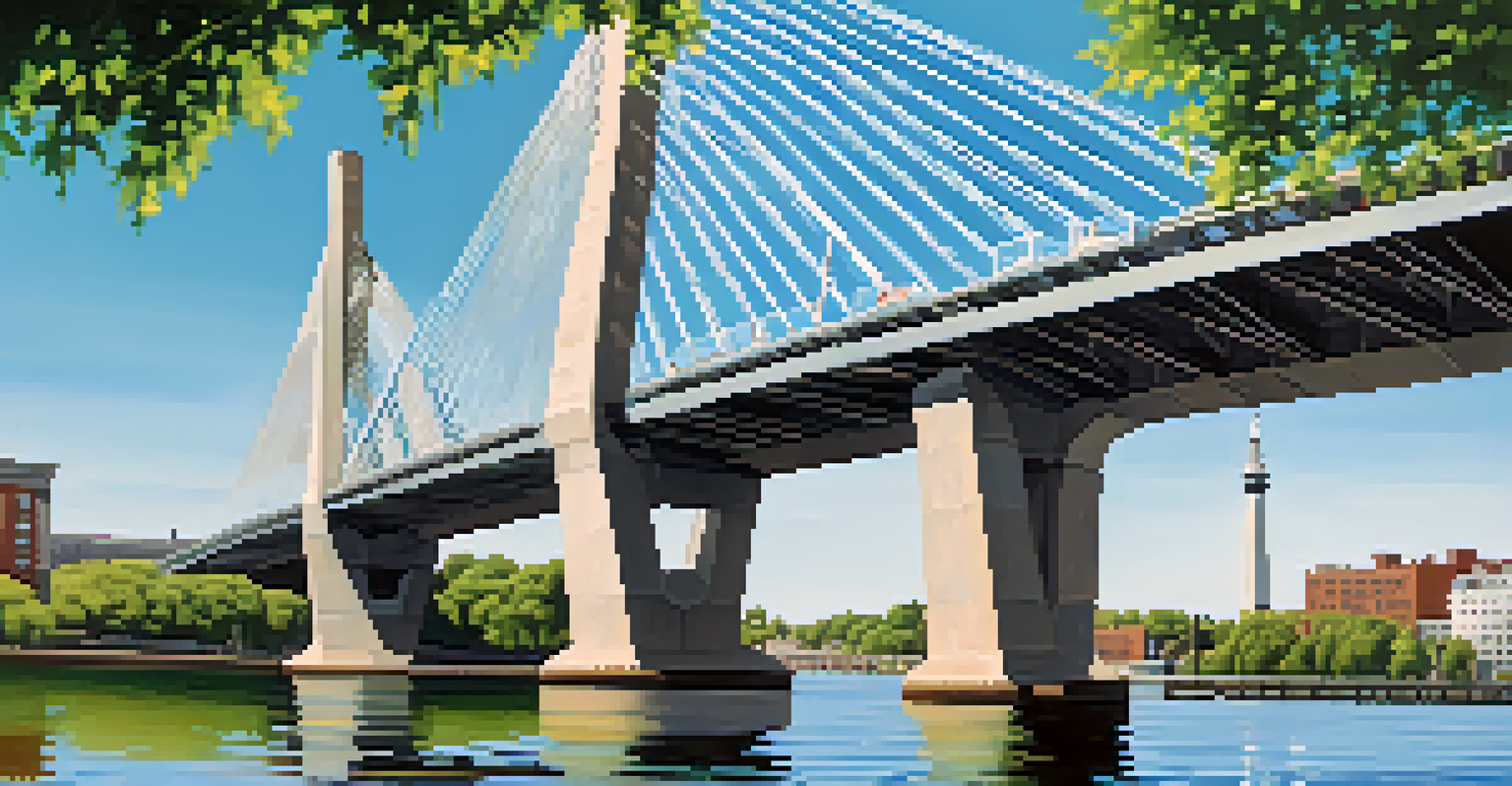The Most Iconic Bridges in Boston: A Historical Overview

The Legendary Charles River Esplanade and Its Bridges
The Charles River Esplanade is not just a beautiful park; it's home to several iconic bridges that connect Boston to Cambridge. Among these, the Longfellow Bridge stands out with its majestic granite arches and stunning views of the skyline. Completed in 1906, this bridge is affectionately nicknamed the 'Salt and Pepper Bridge' due to its distinctive towers that resemble spice shakers.
Bridges are not just physical structures; they are symbols of connection, community, and the human spirit.
Walking across the Longfellow, you can almost feel the echoes of history, as it has been a vital link between the two cities for over a century. It's not just a commuter route; it's also a scenic pathway for joggers and cyclists, offering picturesque views that change with the seasons. The Esplanade itself, with its beautiful riverfront, serves as a reminder of Boston's deep-rooted connection to its waterways.
Other notable bridges in the Esplanade area include the iconic Arthur Fiedler Footbridge, which connects pedestrians directly to the park. This bridge symbolizes the integration of nature and urban life, making it a cherished spot for leisurely strolls and community events. Each span tells a story of innovation and design, reflecting Boston's evolution over the years.
The Historic Zakim Bridge: A Modern Marvel
One of the most recognizable structures in Boston is the Leonard P. Zakim Bunker Hill Memorial Bridge. Opened in 2003, it features striking cable-stayed design that gracefully arches over the Charles River. The bridge was named in honor of Leonard Zakim, a prominent civil rights leader, and it stands as a testament to the city's commitment to inclusivity and history.

Not only does the Zakim Bridge serve as a vital transportation link, but it also symbolizes the renewal of the city’s landscape after the Big Dig project. This massive infrastructure initiative transformed Boston’s roadways, and the bridge became a focal point of that transformation. Its unique design can be admired from various vantage points across the city, making it a favorite for photographers.
Bridges Connect Boston and Cambridge
The Charles River Esplanade features iconic bridges like the Longfellow Bridge, serving as vital links and scenic pathways between the two cities.
As you cross the bridge, you are treated to stunning views of the city’s skyline and the historic Bunker Hill Monument. The Zakim Bridge connects key highways and provides access to the TD Garden, making it an integral part of Boston's urban layout. It’s a perfect blend of functionality and artistry, embodying the spirit of modern Boston.
The Old North Bridge: A Revolutionary Landmark
Steeped in history, the Old North Bridge in Concord, just a short drive from Boston, is famous for its role in the American Revolution. It was here that the 'shot heard 'round the world' was fired in 1775, marking the start of the conflict between the colonies and Britain. This wooden bridge, though replaced over the years, remains a symbol of American liberty and resilience.
The beauty of a bridge is not just in its design, but in the paths it opens for people and ideas.
Visiting the bridge today allows you to walk in the footsteps of the patriots who fought for independence. The surrounding area is adorned with monuments and historical markers that tell the story of that fateful day. The bridge serves not only as a crossing over the Concord River but also as a reminder of the sacrifices made for freedom.
In addition to its historical significance, the Old North Bridge offers a serene landscape for visitors. The picturesque setting, with its lush greenery and tranquil waters, provides a stark contrast to the turbulent history it represents. This blend of history and natural beauty makes it a must-visit for anyone exploring the Boston area.
The Mystic River Bridges: Connecting Communities
The Mystic River is another significant waterway that boasts several bridges, each with its own unique character and history. The Mystic River Bridge, completed in 1971, is a vital connection between Boston and the surrounding communities of Somerville and Medford. Its simple yet efficient design highlights the importance of functionality in urban infrastructure.
As you traverse the Mystic River Bridge, you can't help but notice the rich tapestry of neighborhoods it connects. From the bustling scenes of Assembly Row to the quiet charm of Medford, the bridge facilitates the daily lives of countless residents. It's a reminder of how infrastructure shapes our interactions and experiences within a city.
Historic Significance of Old North Bridge
The Old North Bridge in Concord symbolizes American liberty, marking the site of the 'shot heard 'round the world' during the American Revolution.
Another notable bridge in this area is the Amelia Earhart Dam, which not only serves as a crossing but also plays a crucial role in flood control and water management. This bridge exemplifies the blend of practicality and innovation that characterizes Boston’s approach to urban planning. Together, these bridges tell the story of community and connectivity along the Mystic River.
The South Station and Its Iconic Rail Bridge
South Station, Boston's busiest transit hub, features an iconic rail bridge that is integral to the city's transportation network. Opened in 1899, this historic station has seen countless travelers and has been a key player in the development of Boston's rail services. The rail bridge connects various routes, making it a vital link for both commuters and long-distance travelers.
The architectural beauty of South Station, combined with the functionality of the rail bridge, showcases the city's commitment to blending history with modern needs. As you stand on the bridge, you can observe trains coming and going, feeling the pulse of the city through its transportation system. It's a dynamic scene that reflects the hustle and bustle of urban life.
Visiting South Station is not just about transport; it’s also a cultural experience. The station houses shops, restaurants, and art installations that celebrate Boston's rich heritage. The rail bridge and station together symbolize the intersection of history, community, and modernity, making it a must-see for anyone exploring the city.
The Boston University Bridge: A College Connection
The Boston University Bridge is a vital connection for students and residents alike, linking Boston University with the vibrant neighborhoods on either side of the Charles River. Opened in 1928, this bridge plays a crucial role in the daily lives of students, providing easy access to classes, libraries, and recreational facilities. Its charming design and scenic views make it a popular spot for both walking and cycling.
As you cross the bridge, you are greeted with stunning vistas of the river and the city skyline, making it a favorite among photographers and tourists. The bridge also holds a quirky feature: it’s one of the few places where boats can pass under a bridge while still being able to see a train pass overhead. This unique aspect of the Boston University Bridge highlights the ingenuity of urban planning.
Innovative Future for Boston's Bridges
Boston's urban planners are focusing on sustainable designs that enhance connectivity and promote healthier lifestyles as the city continues to evolve.
The area surrounding the bridge is lively, filled with cafes, parks, and student activities, creating a vibrant atmosphere. It’s not just a bridge; it’s a hub of community life, reflecting the youthful energy of Boston University. The Boston University Bridge serves as a reminder of how infrastructure can enhance both connectivity and community.
The Fort Point Channel and Its Historic Bridges
The Fort Point Channel area is home to several historic bridges that showcase Boston's maritime heritage. The Northern Avenue Bridge, built in 1908, is a notable swing bridge that once allowed ships to pass through the channel. Although it is no longer in operation, it remains a beloved landmark for locals and tourists alike.
Walking along the Fort Point Channel, you can appreciate the blend of history and modern development that characterizes this area. The bridges here are not just functional; they are also part of the narrative of Boston's evolution as a bustling port city. The scenic views of the channel, framed by the city skyline, create a picturesque backdrop for leisurely strolls.

In recent years, there has been a push to revitalize the Northern Avenue Bridge, sparking discussions about its potential future use. This reflects the ongoing conversation about preserving historical landmarks while accommodating modern needs. The Fort Point Channel bridges continue to be a crucial part of Boston's identity, bridging the gap between its past and future.
The Future of Bridges in Boston: Innovation Meets Tradition
As Boston continues to grow and evolve, the future of its bridges is becoming a topic of great interest. Urban planners are exploring innovative designs that blend sustainability and technology, ensuring that new structures will meet the needs of a changing city. This approach honors the historical significance of existing bridges while paving the way for modern infrastructure.
One exciting development is the focus on enhancing pedestrian and cycling access across these vital connections. Bridges are no longer just meant for vehicles; they are becoming part of a larger network that encourages healthier, more active lifestyles. This shift reflects a growing awareness of the importance of community spaces in urban planning.
As we look ahead, the vision for Boston's bridges is clear: to create a harmonious balance between history and innovation. With ongoing projects and discussions about preserving historical sites while embracing modern technology, Boston's iconic bridges will continue to inspire and connect generations to come. The story of these bridges is far from over, and their future is brighter than ever.